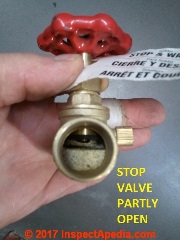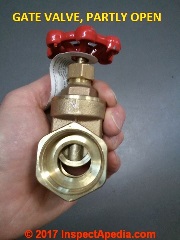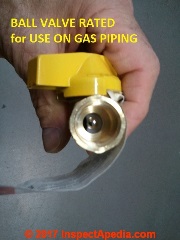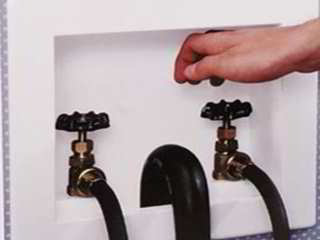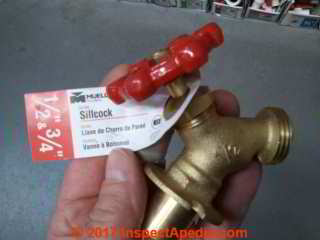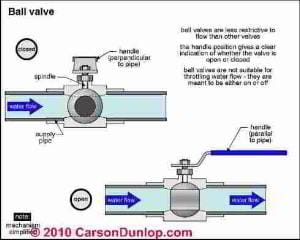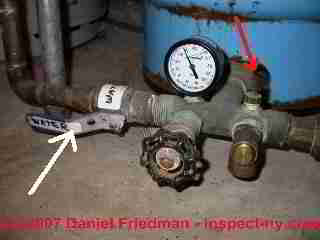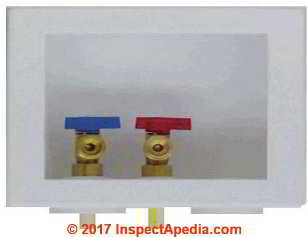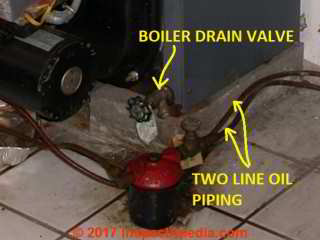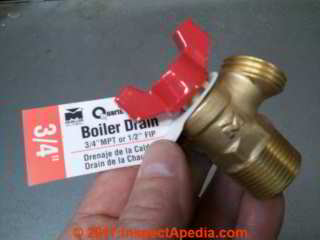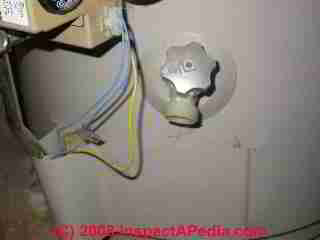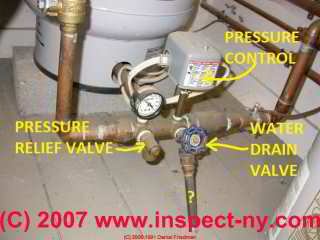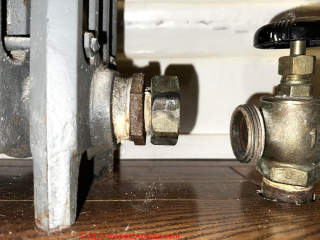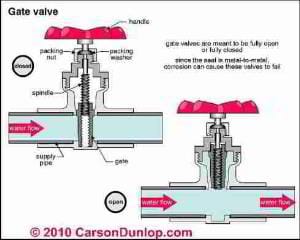 Plumbing System Controls & Valves
Plumbing System Controls & Valves
Index to all types of plumbing valves & controls
- POST a QUESTION or COMMENT about plumbing system valve types & applications
Plumbing valves guide:
This article describes and illustrate the different types of valves found on water supply and drainage systems as well as plumbing fixture valves and on other plumbing and heating devices & fixtures.
We discuss the definitions of globe valves, gate valves, and ball valves, the properties of drain valves installed on water heaters, water tanks, heating boilers etc. . We describe stop valves, boiler drains, fuel valves, check valves, foot valves, etc.
This list of the types of control valves found in residential and light commercial buildings includes links to more-detailed information about each valve type.
We explain stop valves installed at plumbing fixtures. Gas and oil piping fuel line stop and control valves & check valves. Links to details about all types of plumbing system valves on supply piping, drain piping, & plumbing fixtures or appliances: check valves, flushometer valves, etc.
InspectAPedia tolerates no conflicts of interest. We have no relationship with advertisers, products, or services discussed at this website.
Types of Plumbing Valves Used on Water Piping: Globe Valve, Gate Valve, Ball Valve Compared
Descriptions of all common stop valves used on plumbing water supply piping are given here.
Above we illustrate the three most-common types of valves used in plumbing, a globe valve, a gate valve, and a ball valve, each shown in a partly-open position.
The yellow handle on the ball valve tells us that this valve is approved for use on gas piping installations. We're showing these valves in a partly-open position to make the valve mechanism more-obvious. But only the globe type stop valve is intended to be left at settings between fully open and fully shut.
Here we use Carson Dunlop Associates ' sketches and our own photographs to define and explain the differences in design and intended of a globe valve, a gate valve, and a ball valve in plumbing applications.
Article Index
- PLUMBING CONTROLS & VALVES
- BALL VALVES ON-OFF FLOW CONTROL
- DRAIN VALVES
- FAUCETS, OUTDOOR HOSE BIBBS - separate article
- FIXTURE VALVES
- FLUSHOMETER VALVES
- FUEL VALVES, GAS, OIL
- GATE VALVES
- GLOBE VALVES
- RADIATOR VALVES & HEAT CONTROLS - separate article
- SADDLE VALVES
- SOLENOID VALVES
- SILLCOCK INSTALLATION & REPAIR - separate article
- OTHER PLUMBING VALVES
- INDEX to ALL VALVES
Globe Valves for Water Flow & On/Off Control
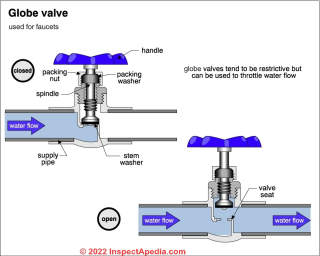 Definition: Globe valves provide easier regulation of water flow but use a washer and valve seat that must be maintained and that can fail from corrosion or pitting.
Definition: Globe valves provide easier regulation of water flow but use a washer and valve seat that must be maintained and that can fail from corrosion or pitting.
Because of the complex valve passage through which water passes in a globe valve there is some water pressure (or flow rate) drop across the valve when it is open.
[Click to enlarge any image]
Globe valves (sketch above) tend to most restrict water flow compared with the gate valve (center) and ball valve (right). But a broken stem on a gate valve can also leave the valve stuck partly or even fully closed (or open), regardless of how you may be able to turn the valve handle.
Globe valves are often used as water shutoff valves on heating boilers, at outdoor hose bibbs or sillcocks, at water pressure tanks, clothes washer connections, and water heaters (calorifiers, cylinders, geysers).
Globe type valves are also used in a smaller form as fixture shutoff valves at sinks and toilets. Globe valves at fixtures are usually referred-to as stop valves.
Our photo above shows a pair of round-handled valves in a washing machine hookup provided by Oatey™. From the small body size of the valve I think these are probably globe valves.
Below is a globe valve used as a sill-cock or outdoor "hose bibb" for connecting a garden hose.
However you may find any of the three water control valves described here installed at a variety of fixtures.
Gate Valves for Water On/Off Control
Definition: Gate valves (sketch just above) are intended to be used in the fully-open or fully-closed position, that is, they are not good for regulating water flow through the valve.
The metal-to-metal seal of a gate valve is also subject to failure from corrosion, and on occasion we have found gate valves with a broken stem that left the valve stuck open or closed.
The user turns the handle and thinks he is changing the valve position but with a broken valve stem the gate does not move.
Ball Valves Used for Water Flow & On/Off Control
Definition of a Ball Valve
Ball valves (photo & sketch shown here) are also a type of gate valve but these controls use a spherical ball type gate with a hole bored through the ball. Turning the handle rotates the ball gate to open or close the valve.
Ball valves, like traditional gate valves, are intended to be left fully open (water on) or fully-closed (water off). Ball valves are also used on gas piping systems.
Watch out: Of the three plumbing valve types described here, only ball-valves are provided in models rated for use on gas piping. Ball valves intended for use on LPG or NPG gas piping will have a yellow handle and will bear a tag giving the valve's listing approval.
Note: on this page we are discussing ball valves used to open or close or shut off the flow of water or other liquids or gases.
If you are looking for information about ball check valves, devices that automatically open or close in response to water or wastewater flow,
see CHECK VALVES, WATER SUPPLY, DRAINS, PUMPS
The white arrow in our photograph above shows a ball valve serving as the main water shutoff control on a water supply system.
You can usually spot a ball valve by its distinctive lever-type handle. When the ball-valve lever-type handle is set parallel to the water pipe the valve is in the open position - as in our photo above.
Gate valves of the traditional gate valve design and the ball valve design both permit water flow through the valve without pressure drop.
If you can see into the opening of a water control valve you can usually determine what type of valve it is. Above we see into the openings of a washing machine hook-up provided by Oatey™. You can see the shiny stainless steel sphere marking these as ball valves.
These special ball valves can be moved from fully-open to fully-closed in just 1/4 turn, especially useful where space is limited..
You may also have noticed the red and blue lever type handles that are characteristic of ball valves. With the washing machine hookup ball valve handle turned across the valve outlet the valve is in the closed position.
L-Port & T-Valves: Design, Usage, Features
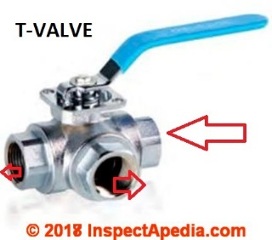
What is a T-valve and what is an L-valve and how are they used?
Above, a T-valve that is used to switch flow between two different output destinations. [Click to enlarge any image]
Typical T-valves such as the Mondeo T-valve shown above, are ball-valves used to divert flow from a primary input source to one of two different destinations. The ball of the valve is drilled straight through and then an intersecting drill opening is made at a 90 degree angle to the first passage.
Ball valves are intended to be used in the fully-open or fully closed position. For a T-valve that means you'd send all of its output to one of two possible destinations. These valves are not usually intended to be used to send output to two destinations simultaneously.
- SK Automation, "Both T-Port and L-Port Valves Should Be Considered for
3-Way Ball Valve Applications" [PDF], SK Automation, S&K Automation, 3530 Olive Ln N, Plymouth, MN 55447 USA, Tel: 1-888-813-6331 Toll Free in USA, (763) 476-1013 - main
(763) 476-6920 - fax, Email: sales@sk-automation.com, retrieved 2018/01/11, original source: http://www.sk-automation.com/images/3_way_ball_valve_white_paper.pdf
Excerpts:
With a L-port the ball is drilled from two different sides (90 degrees) and the drilling resembles the shape of an L. The T-port valve is basically the L-port valve, but the ball is drilled all the way through in one direction. So the drilling of the ball resembles the shape of the letter T.
With a L-port, the middle port is the common port, and with a T-port, one of the side ports is the common port. But this assumes you want to use a T-port ball to divert as you would an L-port ball valve.
Definition & Common Applications for a L-port ball valve:
Divert a flow from one source tank to another source tank,
Divert a flow from one source, like switching between pump #1 and pump #2,
Diverting from free cooling to using a chiller due to seasonal demand
Diverting a flow to one storage tank to another storage tank
Definition & Common Applications for a T-port ball valve:
The applications are basically the same, but you can flow straight thru the valve in position #1 and have less pressure loss and then divert in another direction in position #2 when you want to choose between using one paint sprayer or both paint sprayers at the same time (all three ports connected)
Piping arrangement suggests that the end port should be the common port
Replacement for lubricated T-port plug valve in tank farms - Boysen, Herman, Kv: What, WHy, How, Whence?, [PDF] Danfoss, (2011) retrieved 2017/12/12 original source: http://heating.danfoss.com/PCMPDF/VFHBG202_kv.pdf for an explanation of the use of Kv l when calculating relative pressure drops among different valves used in piping systems.
- Also see SHUTOFF VALVE LOCATION, USE for a discussion of how to find, use, & repair building water supply shutoff valves and stop valves.
Drain Valves: boilers, water heaters, water pressure tanks
- Boiler drain valve: (photos above) On heating boilers and steam boilers the drain valve attached on or close to the boiler body is commonly called a boiler drain. Our photos above illustrate globe valves used as the drain control on heating boilers. The most-common boiler drain valve uses a globe valve internal design.
Other drains on hydronic heating system may be present such as a drain on the heating system's expansion tank.
See EXPANSION TANK DRAIN & AIR RE-CHARGE
- Water heater drain valve: (photo above) Water heater or water cylinder tank drain valves are usually a globe valve design just as the drains on heating boilers. But water heater drain valves are often made of plastic.
Watch out: fooling with a plastic-stemmed water heater drain valve can surprise you when the heat-aged valve stem breaks and water spurts into the building through the valve head. Do not force a stuck water heater drain valve.
WATER HEATER DRAIN PROCEDURE - illustrates water heater drain valves
- Water pressure tank or water storage tank drain valve (shown above) - used to empty the tank for repair or service or for bladderless-tanks, to renew the tank's lost air charge.
See WATER TANK DRAIN VALVE - explains and helps locate drain valves used on water pressure tanks.
Watch out: Often an unused or rarely-used plumbing valve may be stuck, may have lost an internal washer, and may otherwise fail to close properly if you touch it.
We advise against attempting to open or adjust heating equipment drain valves unless you are prepared to shut down the system and install a replacement valve in the event of a leaky valve that can't be shut off.
Fuel Valves: oil & gas piping in buildings

- GAS SHUTOFF VALVES, LP or NATURAL
- Also see GAS PIPING, VALVES, CONTROLS
- Also see OIL & GAS PIPING
- OIL SUPPLY LINE SAFETY VALVES, OSVs - shown above
Plumbing & Plumbing Fixture Valves
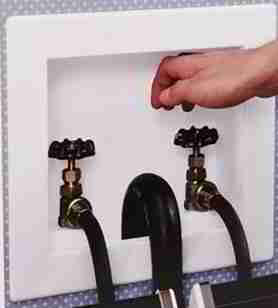
Typically at a sink or toilet the water supply is controlled by a local stop valve.
- Appliance water control valves - installed at some dishwashers (usually hidden below the appliance) and at washing machines
- FAUCETS & CONTROLS, KITCHEN & BATH - types, choices, installation recommendations and best practices guide
- FLUSHOMETER VALVES for TOILETS URINALS - with adequate water pressure, flow, and volume and proper installation, the flushometer valve eliminates the requirement for a water reservoir tank at toilets and supports urinals in restrooms
Thanks to Carson Dunlop Associates, a Toronto Home Inspection Firm and Home Inspection Educator, for permission to use sketches shown in this article
Electric Solenoid Operated Gas, Oil, Water Valves used in Buildings
Here we describe electrically operated plumbing valves used for water control of equipment or piping in buildings.
Reader Question: where can I buy a solenoid-operated water shut-off valve?
15 January 2015 Martin said:
... Any ideas where I can purchase solenoid-operated water shut-off valves?
This question and our reply were posted originally at WATER TANK: USES, TROUBLESHOOTING.
Reply:
Martin a number of companies provide electrically-operated solenoid-type shutoff valves including valves that can close off a water supply line. The operating pressure range and piping diameters among the various products vary so you’ll want to contact the company’s technical or sales people to discuss your specific needs.
Prices for electric solenoid valves range from under $50. U.S.D. to over $500. U.S.D. depending on the application.
See ELECTRIC SOLENOID VALVES for a detailed list of electric solenoid controlled valve manufacturers and vendors.
List of Types of Electrical & Solenoid Valves used in Buildings & on Building Mechanical Systems
Examples of types of electrically operated or solenoid operated valves used in buildings include
- ELECTRIC SOLENOID VALVES - operating water, liquid fuels, some gas fuels
- LOW WATER CUTOFF VALVES - safety feature on hydronic hot water boilers and steam boilers
- OIL LINE QUICK STOP VALVES - safety device on fuel oil and heating oil lines
- ZONE VALVES, HEATING - control of flow of hot water in heating systems and for indirect fired water heaters or calorifiers or geysers
- THERMOSTATIC EXPANSION VALVES solenoid valves used in HVAC systems such as the reversing valve in a heat pump
- WATER SOFTENERS & CONDITIONERS - Other solenoid operated valves that are integral parts of building mechanical systems such as water softener regeneration cycle or backwash cycle control valves.
Our complete list of types of control valves use in buildings and on building mechanical systems is found at CONTINUE READING .
Radiator Valves
See RADIATOR VALVES & HEAT CONTROLS
Saddle Valves or T-Puncture-Valves
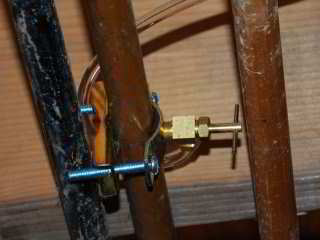 Saddle valves, also referred to as piercing valves or puncture valves, have been used to add low-flow water connections to refrigerator ice makers, humidifiers, and other appliances.
Saddle valves, also referred to as piercing valves or puncture valves, have been used to add low-flow water connections to refrigerator ice makers, humidifiers, and other appliances.
The saddle valve shown above, adapted from a Wikipedia illustration, has a plastic tube attached, perhaps feeding an ice maker. - Retrieved 2018/01/11 original source https://en.wikipedia.org/wiki/Saddle_valve#/media/File:Saddle_valve.jpg
The valve body clamps onto an existing copper water pipe.
When the valve's T-handle is turned down a pointed end on the valve gate pierces the copper piping.
When the valve is backed open water can flow into tubing attached to the saddle valve outlet.
In our OPINION these valves, though convenient, do not work reliably if the valve must be frequently opened or closed.
Watch out: saddle valves are prohibited by some plumbing codes in some jurisdictions such as the U.S. Florida Plumbing Code, the Virginia Plumbing Code, and the 2009 IPC. Other plumbing codes do not explicitly approve the use of saddle valves but do not mention them by name.
2009 International Plumbing Code & Virginia Plumbing Code
605.9 Prohibited joints and connections. The following
types ofjoints and connections shall be prohibited:
1. Cement or concrete joints.
2. Joints made with fittings not approved for the specific
installation.
3. Solvent-cementjoints between different types of plastic
pipe.
4. Saddle-type fittings.
707.1 Prohibited joints. The following types of joints and connections shall be prohibited:
1. Cement or concrete joints.
2. Mastic or hot-pour bituminousjoints.
3. Joints made with fittings not approved for the specific installation.
4. Joints between different diameter pipes made with elastomeric rolling O-rings.
5. Solvent-cementjoints between different types of plastic pipe.
6. Saddle-type fittings.
Plumbing Code Examples Prohibiting Saddle Valves
- UNIFORM PLUMBING CODE (2009) complete [PDF] IPC ICC version
- VIRGINA PLUMBING CODE, CHAPTER 6, WATER SUPPLY AND DISTRIBUTION [PDF] (2006)
- BUILDING CODE DOWNLOADS - master list
Other Plumbing System Control Valves, Check Valves, Faucets, Foot Valves, Water Shutoffs
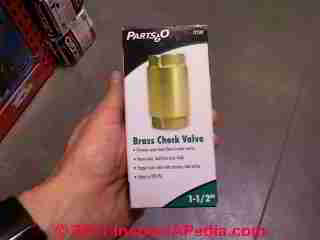
- CHECK VALVES, WATER SUPPLY, DRAINS, PUMPS or backflow preventers are used on on water supply piping are used on well piping systems to prevent back-contamination of the public water supply.
Note that in many jurisdictions use of a conventional check valve is not a suitable substitute for a backflow preventer. - CHECK VALVES, WATER SUPPLY, DRAINS, PUMPS - on water supply piping are used on well piping systems to prevent loss of pump prime.
- CHECK VALVES, DRAIN LINE - on building drain and sewer piping and at sewage ejector pumps are used on building drain and sewer piping to prevent backflow or sewage into the building
- FAUCETS & CONTROLS, KITCHEN & BATH - types & features of faucets used at sinks & tubs
- FAUCETS, OUTDOOR HOSE BIBBS - outdoor faucets, hose bibbs, sill cocks, hose hookups, and freeze-proof faucets
- FOOT VALVES - on the bottom end of well piping in the well, to avoid loss of prime
- MAIN WATER SHUTOFF VALVE - controls water supply to the building whether delivered by municipal water main or by private pump and well system
- RADIATOR VALVES & HEAT CONTROLS
- SILLCOCK INSTALLATION & REPAIR - hose bibbs
- WATER FEEDER VALVES, HYDRONIC BOILER and WATER FEEDER VALVE, STEAM
- WATER PRESSURE REDUCER / REGULATOR - a specialized water control valve that regulates water pressure within the building as municipal water supply pressure varies. Also see WATER PRESSURE REGULATOR ADJUSTMENT
- Water WATER SOFTENER ADJUSTMENT & CONTROLS include a bypass valve that takes the water softener out of operation
- WATER TANK AIR VOLUME CONTROLS and WATER TANK AIR INLET VALVE control the volume of air required in the water pressure tank
- WATER TANK RELIEF VALVE should be installed on all water pressure tanks
- WELL PIPING FOOT VALVES
Reader Comments, Questions & Answers About The Article Above
Below you will find questions and answers previously posted on this page at its page bottom reader comment box.
Reader Q&A - also see RECOMMENDED ARTICLES & FAQs
On 2024-01-23 by InspectApedia Publisher - how do we connect two pipes of different heights
@Connection challenge,
Simplest and easiest would be to unscrew the valve from the vertical riser pipe and use a suitable diameter pipe nipple that's female threads on one hand and mail on the other.
That fitting can raise the valve outlet up to the necessary height to connect to the radiator.
You'll find the female x male thread coupler / extender and your local plumbing supplier or from online vendors and a range of various lengths and diameters to match both your pipe size and the necessary change in height.
[Ed. note: this question was originally posted on our home page and moved to this relevant topic page.]
On 2024-01-23 by Connection challenge
What's the best way to connect this radiator to the haseat pipe? Im having trouble finding an offset radiator connection. radiator. The floors were replaced and the contractor didn't consider the pipe height.
We raised it with him but he refused to fix it. We didn't notice until after our final payment. Now we have to deal with it. See the image
Reader Question: Installing a pressurized system & Flushometer Valve Toilets & Urinals on a Well & Pump Water Supply System
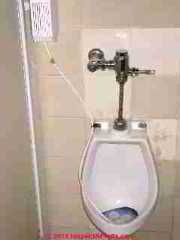 I have a well system at a marina and would like to install commercial flushometer toilets and urinals. It is old and is currently served by a standard residential system.
I have a well system at a marina and would like to install commercial flushometer toilets and urinals. It is old and is currently served by a standard residential system.
I have space above the rest rooms and would like to install a stand alone pressurized system that is fed by the existing residential system, but would provide the gpm and pressure to function the commercial units. Likely to be a total of 3 toilets and two urinals.
Any ideas or plans available? Thanks, Bill
Reply: Be sure that your well water supply system, pressure tank, pressure, and water supply piping diameter & flow rate can support flushometer valves; consider waterless urinal fixtures.
Bill, there is no technical reason why one could not install flushometer type toilets and urinals at a property served by a standard pump and well system, but the cost and trouble may be more than first meets the eye.
Where we find flushometer type toilets and urinals installed it's usually at a building served by municipal water supply and employing larger diameter water supply piping than the 1/2" pipe usually found at residential type properties.
That's because flushometer fixtures, relying on both water pressure and total gpm flow rate to work properly, need a higher pressure and total flow rate than most residential systems deliver
You can achieve the necessary pressure and water quantity for the fixtures by adding a water tank and pump at a suitable location, but you might need also to install larger diameter water supply piping to each fixture.
Details about flushometer valves and their installation, troubleshooting, diagnosis and repair are now found
at FLUSHOMETER VALVES for TOILETS URINALS.
Reader Question: what's the purpose of the inline float valve at the top of an electric water heater? Can I remove it?
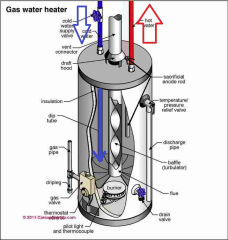 What is purpose of & is it necessary ? In- line ball- cock valve in water entry line going into top of electric water heater. Would it be ok to eliminate line containing floating ball ? It sticks & completely restricts my hot water flow. - Randall Doran
What is purpose of & is it necessary ? In- line ball- cock valve in water entry line going into top of electric water heater. Would it be ok to eliminate line containing floating ball ? It sticks & completely restricts my hot water flow. - Randall Doran
Reply: thermosiphon prevention device?
Randall,
I'm guessing from your description that you are describing an anti-siphon valve at the top of your water heater. The valve is intended to prevent hot water from circulating up into the building water supply piping by "gravity" (warm or hot water, being less dense than cold water, will naturally rise up out of a hot water tank into cooler water in building piping).
If that's what you've got you could remove the valve but the result might be wasted energy - sending hot water out into building piping (where it will cool off) when no hot water is being drawn at a plumbing fixture.
In general you could eliminate a control valve feeding water into your water heater, but it will make it impossible to turn off "hot" water in the building when service or repair to the heater is needed - you'll instead have to turn off water to the whole building.
Watch out: An improperly installed shutoff valve on a water heater can be very dangerous, risking an explosion. Usually the "hot water tank shutoff valve" is installed only on the cold water pipe coming into the water tank. There should be no shutoff valve installed on the hot water line leaving the water tank.
See WATER HEATER SAFETY
We discuss details about water heater controls
On 2020-02-04 - by (mod) -
Christine
No, "controls is a more-broad term that may include things other than "valves" that open or close water flow.
For example a water heater temperature control might be sold under "plumbing controls."
"Plumbing controls" is a rather vague term that might include
shutoff valves
pressure regulators
anti-scald devices
even air bleeders and other devices, even toilet flush valves
On 2020-02-01 by Anonymous
@Christine Khainza,
When they ask you controls, does mean valves?
On 2020-02-01 by Christine Khainza
Does it mean controls are the same as Valves as used in plumbing.
On 2020-02-01 by Christine Khainza
I would really want to understand what controls are as used in plumbing .
On 2019-12-31 by Seline
Some of the most frequently utilised valves for residential plumbing jobs include; Gate Valve, Ball Valve, Globe Valve, Butterfly Valve, Fixture Shutoff Valve, Check Valve, and Pressure-Reducing Valve.
On 2014-05-24 - by (mod) -
Anon please see the clogged drain repair suggestions at
https://inspectapedia.com/plumbing/Drain_Clog_Diagnosis.php
On 2014-05-23 by Anonymous
how to repair a stopped up urinal, should i loosen the p trap to clean out?
On 2012-04-08 by Anonymous
What are the hazards of putting a shut off valve on the hot water line on a gas fired hot water heater?
...
Continue reading at BACKFLOW PREVENTER VALVE, HEATING SYS or select a topic from the closely-related articles below, or see the complete ARTICLE INDEX.
Or see these
Recommended Articles
- AIRBOUND HEAT SYSTEM REPAIR by WATER FEED VALVE - discusses air bleeder valves
- BACKFLOW PREVENTERS, HEAT used on hot water heating systems
- BACKFLOW PREVENTER, HEATER WATER FEEDER
- BACKWATER VALVES, SEWER LINE
- CHECK VALVES, HEATING SYSTEM - used on hot water heating systems
- DRAIN VALVES: also referred to as boiler drains, tank drains, are found on water pressure tanks, water heater tanks, heating boilers, steam boilers, range boilers, and other tanks and containers.
See EXPANSION TANK DRAIN & AIR RE-CHARGE - on heating boilers
See WATER TANK DRAIN VALVE
See WATER HEATER DRAIN PROCEDURE and WATER TANK DRAIN VALVE - CHECK VALVES, WATER SUPPLY, DRAINS, PUMPS
- FAUCETS & CONTROLS, KITCHEN & BATH
- FAUCETS, OUTDOOR HOSE BIBBS
- LOW WATER CUTOFF VALVES on hot water or hydronic heating systems
- LOW WATER CUTOFF CONTROLS on steam heating systems
- MIXING / ANTI-SCALD VALVES - found on tankless coils used for making domestic hot water and at other hot water supply systems that produce very hot water; also found installed directly at some plumbing fixtures such as sinks, tubs, and showers.
Also see MIX VALVE SCALD PROTECTION, Best Practices - OIL SUPPLY LINE SAFETY VALVES, OSVs
- RADIATOR VALVES & HEAT CONTROLS - valves used on hot water, hydronic, and steam heating systems
- Temperature & Pressure RELIEF VALVES
- SILLCOCK INSTALLATION & REPAIR
- FLUE GAS SPILL SWITCH TRIPPING & RESET may act as either a control that turns off the gas burner or shut off the gas supply to the appliance
- WATER FEEDER VALVES, HYDRONIC BOILER
- WATER FEEDER VALVE, STEAM heat systems
- ZONE VALVES, HEATING
Watch out: do not touch, open, or otherwise manipulate relief valves on heating equipment unless you are prepared, should the valve leak, to shut down the heater and replace the leaky valve immediately.
Suggested citation for this web page
PLUMBING CONTROLS & VALVES at InspectApedia.com - online encyclopedia of building & environmental inspection, testing, diagnosis, repair, & problem prevention advice.
Or see this
INDEX to RELATED ARTICLES: ARTICLE INDEX to PLUMBING VALVES
Or use the SEARCH BOX found below to Ask a Question or Search InspectApedia
Ask a Question or Search InspectApedia
Try the search box just below, or if you prefer, post a question or comment in the Comments box below and we will respond promptly.
Search the InspectApedia website
Comments & Questions are Welcome Here
If you posted comments here and no longer see what you wrote, please check for your comment in the Reader Q&A found above on this page.
Citations & References
In addition to any citations in the article above, a full list is available on request.
- Thanks to reader - R.S. (anonymous by req.) for discussing hot water loss problems - August 2010
- [1] Helvex
- [2] Sloan Valve Company, 10500 Seymour Ave., Franklin Park IL 60131, Tel: 847-671-4300, website: sloanvalve.com
- [3] Sloane-Regal Installation Instructions for Standard Exposed Closet and Urinal Flushometers, Regal I.I. Code 816312, Models 110/111 through Model 117. 120-122, and 180, 186, 1997, Sloan Valve Company, 10500 Seymour Ave., Franklin Park IL 60131, Tel: 847-671-4300, website: sloanvalve.com
- [4] Sloane Installation Instructions for Exposed Regal® XL Water Closet and Urinal Flushometers, Code 0816312 (newer version of above document), Rev. 1 05/10, Sloan Valve Company, 10500 Seymour Ave., Franklin Park IL 60131, Tel: 800-982-5839, or 888-SLOAN-14 / 888-756-2614, website: sloanevalve.com
- In addition to citations & references found in this article, see the research citations given at the end of the related articles found at our suggested
CONTINUE READING or RECOMMENDED ARTICLES.
- Carson, Dunlop & Associates Ltd., 120 Carlton Street Suite 407, Toronto ON M5A 4K2. Tel: (416) 964-9415 1-800-268-7070 Email: info@carsondunlop.com. Alan Carson is a past president of ASHI, the American Society of Home Inspectors.
Thanks to Alan Carson and Bob Dunlop, for permission for InspectAPedia to use text excerpts from The HOME REFERENCE BOOK - the Encyclopedia of Homes and to use illustrations from The ILLUSTRATED HOME .
Carson Dunlop Associates provides extensive home inspection education and report writing material. In gratitude we provide links to tsome Carson Dunlop Associates products and services.


